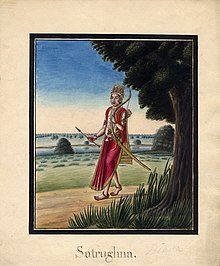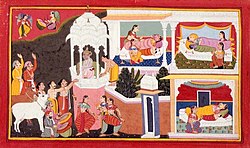Shatrughna
This article needs additional citations for verification. (April 2020) |
| Shatrughna | |
|---|---|
 Shatrughna, the youngest brother of Rama bhagwan and was almost like a devotee to bharat | |
| Affiliation | Avatar of Sudarshan Chakra |
| Texts | Ramayana and its other versions |
| Personal information | |
| Parents | Dasharatha (father) Sumitra (mother) Kaushalya (step-mother) Kaikeyi (step-mother) |
| Siblings | Lakshmana (brother) Rama (half-brother) Bharata (half-brother) Shanta (half-sister) |
| Spouse | Shrutakirti |
| Children | Subahu Shatrughati[1] |
| Dynasty | Raghuvanshi-Ikshvaku-Suryavanshi |
Shatrughna (Sanskrit: शत्रुघ्न, romanized: śatrughna, lit. 'killer of enemies') was a brother of Lord Rama in the Hindu epic Ramayana. He is also known as Ripudaman (oppressor of foes). He was the twin of Lakshmana and was like a devotee of Bharat like Lakshman was to lord Ram. According to Valmiki Ramayana, Shatrughna was one half component of manifest Vishnu (Rama). Shatrughna also appears as the 412th name of Vishnu in the Vishnu Sahasranama of the Mahabharata.
According to the Ramayana, Rama was the seventh avatar of Vishnu, while Lakshmana, Shatrughna and Bharata were part-incarnations of Sheshanaga, Shankha and Sudarshan chakra respectively.[2]
The Khuthan block of Jaunpur district of the Indian state of Uttar Pradesh is named after him.
Birth and family[]

Shatrughna was born to the virtuous king of Ayodhya, Dasharatha, and his second wife, Queen Sumitra, a princess of Kashi. Dasharatha's other two wives, Kaushalya and Kaikeyi, had sons as well. Kaushalya had Rama and Kaikeyi had Bharata, who were Shatrughna's half-brothers. Shatrughna's twin brother was Lakshmana. Shatrughna was married to Shrutakirti, daughter of Kushadhwaja, Janaka's younger brother. Thus, Shrutakirti was Sita's cousin. They had two sons - Subahu and Shatrughati.
Rama's exile[]

When Rama was exiled, Shatrughna dragged Kaikeyi's old nurse Manthara (who was responsible for poisoning the queen's mind against Rama) and tried to kill her, but he was restrained by Bharata, who felt that Rama would not approve.
Bharata went to Rama and asked him to come back to Ayodhya, but Rama refused. Bharata ruled Ayodhya from Nandigramam and was an excellent leader, often referred to as the avatar of dharma. Though Bharata was the king designate of Ayodhya during Rama's exile, it was Shatrughna who took care of the administration of the whole kingdom during Rama's absence. Shatrughna also was the only solace for the three queen mothers during the absence of Rama, Lakshmana and Bharata from Ayodhya.
Rebuked Manthara[]
Manthara appears only once in the Ramayana after Rama's banishment. Having been rewarded by Kaikeyi with costly clothing and jewels, she was walking in the palace gardens when Bharata and his half-brother Shatrughna came upon her. Seeing her, Shatrughna flew into a violent rage over Rama's banishment and assaulted her murderously. Kaikeyi begged Bharata to save her, which he did, telling Shatrughna that it is a sin to kill a woman and that Rama would be furious with them both if he did such a thing. He relented and the brothers left, while Kaikeyi attempted to comfort Manthara.
The Slaying of Lavanasura[]

Although he played a relatively minor role in the Ramayana, Shatrughna was important to the main story and goal of the epic. His chief exploit was the killing of Lavanasura, the demon King of Madhupura (Mathura),[3] who was a nephew of Ravana, the King of Lanka, slain by Rama.
Lavanasura was the son of Madhu, the pious demon-king after whom the city of Madhupura was named. Madhu's wife and Lavanusara's mother Kumbhini was a sister of Ravana. Lavanasura was holder of the divine Trishula (Trident) of Lord Shiva, and nobody was able to kill him or prevent him from committing sinful activities.[4]
Shatrughna begged Rama and his elder brothers to allow him the opportunity to serve them by killing Lavanasura. Shatrughna killed the demon with an arrow imbibed with the power of Vishnu. After Lavanasura's death, Rama crowned him King of Madhupura.[5]
Retirement[]
After Rama, the seventh Avatar of Vishnu completed 11,000 years of perfectly pious rule upon earth, he walked into the river Sarayu to return to his true and eternal Mahavishnu form. Bharata and Shatrughna followed him into the river and merged into Mahavishnu.
Temples[]
- Shatrughna Temple at Payammal in Thrissur District of Kerala
- Shatrughna Temple at Muni Ki Reti, Rishikesh
- Shatrughna Temple near Kans-tila, Mathura, UP
References[]
- ^ Ramayana – Conclusion, translated by Romesh C. Dutt (1899)
- ^ Naidu, S. Shankar Raju; Kampar, Tulasīdāsa (1971). A comparative study of Kamba Ramayanam and Tulasi Ramayan. Shank. University of Madras. pp. 44, 148. Retrieved 21 December 2009.
- ^ Pargiter, F.E. (1972). Ancient Indian Historical Tradition, Delhi: Motilal Banarsidass, p.170.
- ^ Kumar, Maltinandan. Chalein Such Ki Aur (in Hindi). Notion Press. ISBN 978-93-5206-582-0.
- ^ Agarwal, Meena (22 September 2016). Tales From The Ramayan. Diamond Pocket Books Pvt Ltd. ISBN 978-93-5261-304-5.
External links[]
- Solar dynasty
- Characters in the Ramayana

